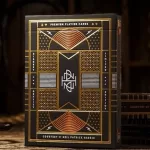There is a great deal of speculation about the history of the humble playing card. But some of the clearer elements of the story will be described below, with a particular focus on the development of the Bicycle® Card.
The earliest playing cards are believed to have originated in Central Asia. The documented history of card playing began in the 10th century, when the Chinese began using paper dominoes by shuffling and dealing them in new games. Four-suited decks with non-figurative court cards evolved in the Islamic world and the earliest authentic references to playing cards in Europe date from 1377. It was in Europe that the Court Cards started to use representations of human beings.
It is from French designs that the cards we use today are derived. France gave us the suits of spades, clubs, diamonds and hearts, and the use of simple shapes and flat colors helped facilitate manufacture. French cards soon flooded the market and were exported in all directions. They became the standard in England first, and then in the British Colonies of America. To this day other European countries use quite different suits. For example, Hearts, Leaves, Bells (round hawkbells) and Acorns in Germany; Shields, ‘Roses’, Bells and Acorns in Switzerland; Coins, Cups, Swords and Clubs (cudgels) in Spain and Mediterranean Italy; Coins, Cups, Swords and Batons in Adriatic Italy.
Americans began making their own cards around 1800. Some of the innovations or refinements which came from the USA included: double-headed court cards (to avoid the nuisance of turning the figure upright), varnished surfaces (for durability and smoothness in shuffling), indexes (the identifying marks placed in the cards’ borders or corners), and rounded corners (which avoid the wear that card players inflict on square corners).
According to the history of Cards from the United States Playing Card Company, during this same period, cycling — on unicycles, bicycles, and tricycles — was taking the country by storm. It was also in the latter part of the decade that Russell & Morgan, the forerunners of the United States Playing Card Company, decided to produce a line of cards of the highest quality. Employees were asked to suggest an attractive name for the new product, and a printer, “Gus” Berens, offered “Bicycle.” His idea was enthusiastically accepted, and the Rider Back made its debut in 1887. Since then, while the Bicycle® brand has featured dozens of different designs, the Rider Back has never gone out of production.
Magicians continue to favour Bicycle® Cards for the way they handle so smoothly, enabling many different sleights, and also for their elegance. Increasingly new technology and lower printing costs are enabling a variety of unusual packs to be produced, including the famous ‘Black Tiger’ deck, and some high contrast coloured decks.







1 Pingback